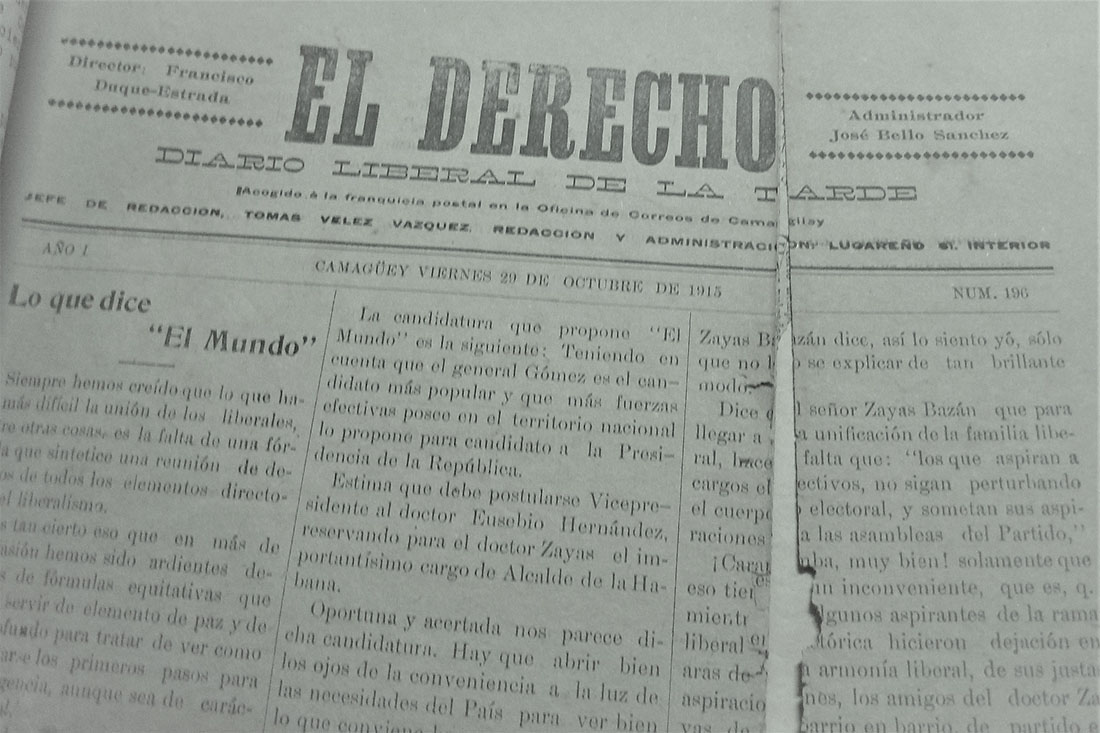El Derecho was a four-page gazette-sized newspaper that, in the context of the journalistic system of Camagüey, distinguished itself for its essentially political purpose, and within that code it aimed to be a platform for the dissemination of the Liberal party. In this sense, he supported the reelection of José Miguel Gómez as president of the Republic and also supported the candidacy of Mr. Gustavo Caballero Arango as governor of the province of Camagüey, both veterans of the war of independence and active politicians.
Camagüey stands out for literature on multiple platforms. On Monday, March 1st, 1915, the newspaper from Camagüey El Derecho was published for the first time. Its director was the writer Mr. Francisco Duque Estrada. The first administrator, the veteran Mr. Honorato Casalís Díaz, who was a sergeant of the Third Corps of the Liberation Army and as Editor in Chief, the teacher and director of Academies Mr. Tomás Vélez Vázquez.
Journalistic context
Since the end of the 17th century, journalism in Cuba, also in Camagüey, underlined the spiritual expression of local and national society. It constituted a means of instruction and cultural enrichment, on a large and medium scale. During the Republic it flourished considerably because those who wrote for the press were very prestigious people. They were generally linked to the Veterans Movement, or they were writers, poets, teachers, politicians, professionals from different branches of knowledge.
They dealt with different topics: economic, social, political, cultural, family, international, scientific, about women, suffrage, constitutions, demands for rights, of important matters, denouncing social ills, often censored and others adjusted to the designs of the hegemonic power.
El Derecho
The head of the newspaper states that it is the Diario Liberal in the afternoon and consequently the front page only contains news of this political profile and specifically of the Liberal party. It is striking how members of the associations of the time such as Antonio Maceo, Victoria, prestigious teachers such as Mr. Tomás Vélez, among other personalities were executives of this newspaper. An absence or little representativeness of women who exercise the trade is perceived, although the popular base of the followers of this party is transparent.
Its Importance
The study of cultural thought from the local press is meritorious, which is part of the historical memory with more than three centuries of development. Camagüey stands out for literature on multiple platforms; journalism is an example of a long-standing autonomous genre and trade. The proposal to distinguish, rescue, investigate and disseminate in depth the knowledge that the local press manages as an expression of the historical heritage of the locality is a great opportunity.
Bibliography
Archivo Histórico Provincial de Camagüey (AHPC) Fondo Jorge Juárez Cano.
Henry Knight, Kezia Zabrina (2020) Asociaciones de instrucción y recreo de negros y mestizos. Contribución al desarrollo educativo y artístico en la sociedad de Camagüey (1879 – 1961). Tesis presentada en opción al grado científico de Doctor en Ciencias Sociológicas. Universidad de La Habana Facultad de Filosofía, Historia y Sociología. Departamento de Sociología
Translated by: Aileen Álvarez García






